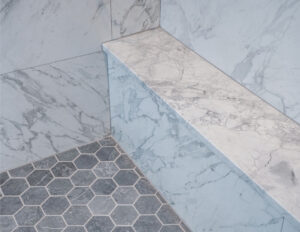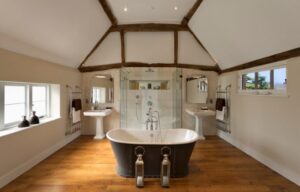Alright, let’s get real about kitchen backsplashes. We’ve all stood in that aisle at the home improvement store, staring at a wall of tiles, feeling a mix of excitement and pure, unadulterated overwhelm. It seems like a small decision, right? But we know the truth. That strip of wall between your countertop and cabinets sets the entire tone for your kitchen. Get it right, and your kitchen sings. Get it wrong, and it’s a constant, tiled reminder of a choice you maybe should have thought about a little longer.
We’re Verified Builders, a remodeling company right here in Denver, and we’ve helped countless folks navigate this exact decision. Think of us as your friendly, neighborhood general contractor, here to chat through the process. So, grab a coffee, and let’s break down how to choose the right backsplash for your kitchen without losing your mind.
Contents
- 1 First Things First: What’s Your Kitchen’s Vibe?
- 2 The Material World: A Tour of Your Options
- 3 The Usual Suspects: Pros, Cons, and Our Two Cents
- 4 Playing with Color, Pattern, and Size
- 5 The Nitty-Gritty: Budget, Installation, and Grout (The Unsung Hero)
- 6 Tying It All Together: The Big Picture
- 7 Wrapping It Up: Your Kitchen, Your Masterpiece
- 8 Frequently Asked Questions
First Things First: What’s Your Kitchen’s Vibe?
Before we even look at a single tile, we need to figure out the personality of your kitchen. Are we going for sleek and modern, cozy and farmhouse, or timeless and traditional? Your backsplash shouldn’t just be a random accessory; it needs to be a supporting actor that makes the star—your kitchen—look even better.
- For the Modern Minimalist: Think clean lines, glossy finishes, and solid colors. Large-format porcelain slabs, glass tiles, or even stainless steel could be your jam.
- For the Rustic Charm Seeker: You’re all about texture and warmth. Subway tile is a classic for a reason, but don’t be afraid to mix in some handcrafted zellige or a natural stone like slate.
- For the Bold and Eclectic: This is your chance to have some fun! A colorful mosaic, a funky geometric pattern, or even some bling with metallic accents can make a huge statement.
Ever walked into a kitchen and felt like something was just… off? Chances are, the finishes were having a silent argument with each other. We see it all the time in our home remodeling projects. The goal is harmony, not a turf war on your wall.
The Material World: A Tour of Your Options
This is where the rubber meets the road. The material you choose affects not just the look, but the durability, maintenance, and, of course, the cost. Let’s get our hands dirty and compare the contenders.
The Usual Suspects: Pros, Cons, and Our Two Cents
Ceramic & Porcelain Tile
This is the workhorse of the backsplash world, and for good reason.
- Pros: Durable, heat-resistant, endless colors and patterns, and generally easy on the wallet. Porcelain is denser and less porous than ceramic, making it a champ against moisture.
- Cons: Grout lines. Oh, the grout lines. They can be a magnet for grease and grime if not sealed properly.
- Our Take: IMO, you can’t go wrong here. It’s a fantastic, budget-friendly option for most kitchens. For a more seamless look, use larger tiles to minimize grout lines.
Natural Stone (Marble, Granite, Quartzite)
Ah, the luxury option. Nothing beats the unique, organic beauty of natural stone.
- Pros: Stunning and one-of-a-kind. Each slab has its own character. It adds immediate value and a high-end feel, perfect for those luxury home renovations.
- Cons: It requires maintenance. Marble, for instance, can etch and stain from acids like lemon juice or vinegar. It’s also on the pricier side.
- Our Take: We love it, but we always give our clients the “talk.” You have to be okay with it developing a patina over time. If you’re a messy cook who loves squeezing lemons, maybe think twice.
Glass Tile
Want to brighten things up? Glass tile is your best friend.
- Pros: It reflects light, making your space feel larger and brighter. It’s non-porous, so it’s incredibly stain-resistant and a breeze to clean.
- Cons: It can show water spots and fingerprints more easily, and the installation requires a skilled hand to avoid cracking the tiles.
- Our Take: A brilliant choice for kitchens with smaller windows or darker corners. It pairs beautifully with under-cabinet lighting.
Metal (Stainless Steel, Copper, Pewter)
Going for that professional chef’s kitchen look? Metal delivers.
- Pros: Ultra-durable, heat-resistant, and easy to wipe down. It creates a seamless look, especially if you match it to your appliances.
- Cons: It can scratch and dent. It also shows every single fingerprint and water droplet, so be prepared to wipe it down frequently.
- Our Take: It looks incredibly cool, but it’s a high-maintenance relationship. Great for a dedicated home chef who doesn’t mind a little daily TLC.
To make this easier, here’s a handy table to compare the front-runners:
| Material | Durability | Maintenance | Cost (Relative) | Best For |
|---|---|---|---|---|
| Ceramic/Porcelain | High | Medium (grout) | $ | Budget-conscious, DIY-friendly projects |
| Natural Stone | Medium-High | High (sealing) | $$$ | Luxury looks, statement pieces |
| Glass Tile | Medium | Low | $$ | Brightening spaces, modern aesthetics |
| Metal | High | High (wiping) | $$ | Industrial/Professional styles |
Playing with Color, Pattern, and Size
Now for the fun part. You’ve picked a material, but how do you want it to look?
Color is Key. Do you want your backsplash to blend in or stand out?
- Neutral Territory: Whites, beiges, and grays are timeless. They create a calm, cohesive look and let your countertops or cabinets be the star. This is a safe bet that you won’t tire of.
- Make a Statement: A pop of color—a deep blue, a vibrant emerald green—can become the focal point of your entire kitchen. It’s a commitment, but oh, so rewarding when done right.
Pattern and Layout are Everything. The same tile can look completely different depending on how you lay it.
- Subway Tile: The classic. But try a herringbone or vertical stack bond pattern instead of the standard horizontal brick pattern for a fresh twist.
- Geometric & Mosaic: These are the patterns that add personality and movement. A word of caution: a little goes a long way. Sometimes, using a busy mosaic as an accent strip is more effective than covering an entire wall.
Size Matters. Ever wondered why some backsplashes look sleek and others look… busy?
- Large Format Tiles: They create a clean, modern, and seamless look with fewer grout lines. Perfect for making a small kitchen feel larger.
- Small Tiles (like mosaics): They add texture and detail but can make a space feel a bit busier. They’re ideal for a smaller accent area or a powder room, but we often advise caution in a large kitchen.
The Nitty-Gritty: Budget, Installation, and Grout (The Unsung Hero)
Let’s talk logistics. This is the part where many DIY dreams meet reality. 🙂
Setting a Realistic Budget. Your budget needs to account for more than just the tile itself. Remember:
- Cost of tile/materials
- Cost of thin-set, grout, and sealers
- Cost of tools (if DIYing)
- Labor cost (if hiring a pro)
FYI, a professional home renovation contractor like Verified Builders can often get materials at a better price and will know exactly how much to order, saving you from costly over-purchasing or frustrating mid-project delays.
To DIY or Not to DIY? We get it, tiling looks like a fun weekend project. And for a small, simple area with straight cuts, it might be. But for complex patterns, tricky corners, or expensive materials, a misstep can be costly. A skilled bathroom renovation contractor or general contractor has the tools and expertise to ensure it’s done perfectly the first time. It’s one of those things that looks easier than it is, trust us.
Grout: Don’t Screw This Up. Grout color can make or break your backsplash.
- Matching Grout: Creates a unified, seamless field of color. Great for making a statement with the tile shape itself.
- Contrasting Grout: Highlights the pattern and layout of each individual tile. It adds definition and a more graphic, often traditional, look.
- Pro Tip: Always use a sealer on your grout, especially in a kitchen. It will repel grease, wine, and sauce spills, making your life infinitely easier down the road. This is a non-negotiable step in our book for any kitchen project.
Tying It All Together: The Big Picture
Your backsplash doesn’t exist in a vacuum. It has to play nice with your countertops, cabinets, and flooring. You don’t want it to clash.
Bring samples home! Hold your tile samples against your countertops and cabinets in the actual light of your kitchen. The lighting in the store is a liar. See how they look in the morning light and under your evening lights.
And think about the long game. That incredibly trendy tile you love now… will you still love it in 5 or 10 years? For a whole house remodeling project, we always advise balancing trendy elements with timeless foundations. That way, you can update the easily changeable things (like paint or decor) without having to re-tile your entire kitchen.
Wrapping It Up: Your Kitchen, Your Masterpiece
Choosing a backsplash is a journey of balancing aesthetics, practicality, and budget. It’s a key player in your kitchen’s story. Take your time, do your research, and don’t be afraid to trust your gut.
And hey, if you start feeling overwhelmed, you know who to call. At Verified Builders, we live for this stuff. Whether it’s a small kitchen update, a full basement renovation, or even a garage conversion, we help Denver homeowners navigate these exact decisions every single day. We can help you source materials, manage the installation, and ensure your vision comes to life without the stress.
So, what are you waiting for? It’s time to turn that kitchen wall into a work of art.
Frequently Asked Questions
Q1: How high should my kitchen backsplash be?
The standard height is 4 inches above the countertop, but the current trend is to go all the way up to the bottom of your wall cabinets for a more dramatic and cohesive look. In some modern designs, people even take it all the way to the ceiling! It’s a personal preference, but going full-height is a great way to add impact.
Q2: Can I install a new backsplash over my old one?
Technically, yes, but we don’t usually recommend it. You’re adding thickness, which can interfere with your outlets and countertop edges. More importantly, you’re only as secure as the layer underneath. If the old tile fails, your new one fails with it. It’s almost always better to take the time to remove the old backsplash and start with a clean, stable surface.
Q3: How do I find a reliable contractor for this project?
Start by searching for a “general contractor near me” or “remodeling company nearest” to you and read their reviews! A company’s reviews are a window into their past work and client relationships. Look for a contractor, like Verified Builders, who specializes in kitchen and bathroom remodeling, has a portfolio you like, and communicates clearly from the start. Don’t just pick the closest or cheapest option; find someone you trust to execute your vision.


